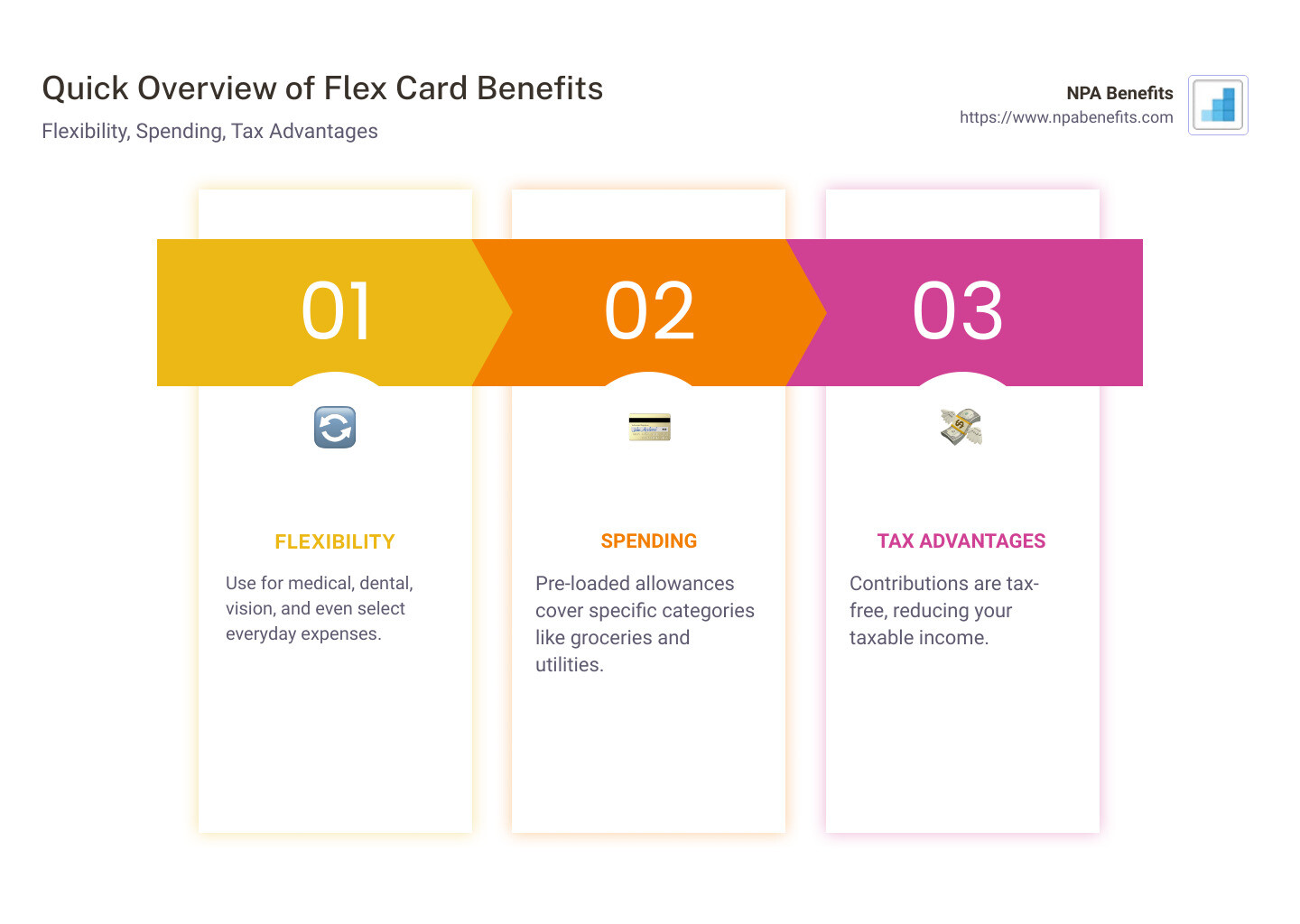A flex card is a financial tool designed to offer flexibility, tax advantages, and ease of spending on various needs, especially healthcare-related expenses. Whether you’re navigating the complexities of health insurance for your small business or trying to manage personal healthcare costs, understanding flex cards can help you maximize your benefits while minimizing out-of-pocket expenses.
Quick Overview of Flex Card Benefits:
– Flexibility: Use for medical, dental, vision, and even select everyday expenses.
– Spending: Pre-loaded allowances cover specific categories like groceries and utilities.
– Tax Advantages: Contributions are tax-free, reducing your taxable income.
In this guide, we’ll dive deep into flex cards, explaining how they work, the types available, and tips on using them effectively. From Medicare flex cards to Flexible Spending Accounts (FSA) debit cards, we’ll cover it all to ensure you have a comprehensive understanding of this valuable financial tool.

What Are Flex Cards?
A flex card is a type of financial tool designed to help you manage specific expenses more effectively. These cards are often linked to Flexible Spending Accounts (FSAs) or other tax-advantaged financial accounts. Let’s break down what these terms mean and how they can benefit you.
Flexible Spending Account (FSA)
An FSA is a special account you can use to pay for out-of-pocket health care costs. You contribute money to this account on a pre-tax basis, which means you don’t pay taxes on the money you put in. This can lead to significant tax savings.
- Example: If you set aside $1,000 in an FSA and you’re in the 22% tax bracket, you save $220 in taxes.
Employers often offer FSAs as part of their benefits package, and they may even contribute to your account, although they’re not required to do so.
FSA Debit Card
An FSA debit card is a convenient way to access the funds in your FSA. Instead of paying out-of-pocket and waiting for reimbursement, you can use this card to pay directly for eligible expenses.
- How It Works: You swipe your FSA debit card at the pharmacy to buy prescription medications, and the amount is automatically deducted from your FSA balance.
These cards are usually branded with Visa, MasterCard, or Discover and work like a regular debit card, but with restrictions on where you can use them. For example, you can use them at pharmacies, doctor’s offices, and other health-related merchants.
Tax-Advantaged Financial Accounts
Tax-advantaged financial accounts like FSAs offer a way to save money on taxes while covering essential expenses. The primary advantage is that the money you contribute to these accounts is not subject to federal income tax, Social Security tax, or Medicare tax.
- Benefits:
- Reduces your taxable income.
- Helps you budget for medical expenses.
- Can be used for a wide range of eligible expenses, from medical supplies to dependent care.
Key Takeaways
- Flexible Spending Accounts (FSAs): Special accounts for out-of-pocket health care costs, funded with pre-tax dollars.
- FSA Debit Cards: Convenient way to access FSA funds directly, without waiting for reimbursement.
- Tax-Advantaged: Contributions reduce your taxable income, offering significant tax savings.
In the next section, we’ll explore the different types of flex cards available, including Medicare flex cards, Amazon flex debit cards, and Flexible Benefits Cards.
Types of Flex Cards
Flex cards come in various forms, each catering to different needs and benefits. Here, we’ll look at three popular types: Medicare Flex Cards, Amazon Flex Debit Cards, and Flexible Benefits Cards.
Medicare Flex Card
A Medicare Flex Card is a preloaded debit card offered by some Medicare Advantage plans. These cards are not issued by the government but by private health insurance companies. They can be used for specific expenses like over-the-counter health items, assistive devices, and even utilities.
Key Points:
– Not Government-Issued: These cards are perks from private Medicare Advantage plans, not traditional Medicare.
– Preloaded Allowance: Funds can range from $250 to $1,500 per year, depending on the plan.
– Eligible Expenses: Groceries, utilities, dental, vision, and hearing care, among others.
Example: According to Politifact, the actual monetary limits and eligible expenses can be more restrictive than advertisements suggest. Always check the fine print of your specific plan.
Amazon Flex Debit Card
The Amazon Flex Debit Card is designed for Amazon Flex drivers. This card offers cash back on purchases, particularly for gas, which can be a significant expense for drivers.
Key Points:
– Gas Discounts: Drivers can earn up to 12% cash back on gas purchases.
– No Minimum Balance: There are no minimum balance requirements, making it easy to use.
– Easy Transfers: Funds can be transferred to other bank accounts, though it may take a couple of days.
User Feedback: “I normally get cash back when I buy groceries. No fee that way and I don’t have to find a no-fee ATM,” shared one Amazon Flex driver on Reddit.
Flexible Benefits Card
A Flexible Benefits Card is typically linked to a Flexible Spending Account (FSA) or Health Savings Account (HSA). These cards allow users to pay for eligible medical and dependent care expenses directly.
Key Points:
– FSA/HSA Linked: Access funds from your FSA or HSA without waiting for reimbursement.
– Wide Range of Expenses: Can be used for medical supplies, eyeglasses, and even dependent care.
– Tax-Advantaged: Contributions reduce your taxable income, offering significant tax savings.
Example: According to NPA Benefits, offering health insurance benefits, including flexible benefits cards, can help with employee recruitment and retention by showing that you prioritize their well-being.
In the next section, we will delve into how flex cards work, covering topics like annual benefits, installment plans, spending limits, and eligibility criteria.
How Flex Cards Work
Flex cards offer a flexible and convenient way to manage healthcare and other eligible expenses. Let’s break down how they work.
Annual Benefit
Some flex cards provide an annual benefit. This means your plan gives you a yearly “allowance” to spend on preapproved items or services. For example, if your plan offers a $1,500 annual benefit, that’s the total amount you can use for the year. This is ideal for budgeting larger expenses upfront.
Installments
Other plans might use an installment approach. Instead of getting a lump sum, money is added to your card throughout the year, either monthly or quarterly. This method helps spread out your spending and can be easier to manage for recurring expenses.
Spending Limits
Flex cards come with spending limits. These limits vary based on your plan, insurance provider, and eligibility. For example, Anthem plans might offer a quarterly spending allowance for over-the-counter health items, groceries, and even utilities. It’s crucial to check your plan details to understand your specific limits and avoid overspending.
Eligibility
Not everyone qualifies for a flex card. Eligibility depends on several factors, including your specific Medicare Advantage plan, geographic location, and whether you qualify for both Medicare and Medicaid (dual-eligible). Each plan sets its own rules for who can get a flex card and what it can be used for.
Example: United Health Care offers the UCard, which combines a member ID card with credits for over-the-counter products and gym memberships. Anthem provides a quarterly spending allowance for items like healthy groceries and assistive devices.
These cards are not issued by traditional Medicare but by private insurers who manage Medicare Advantage plans. Eligibility and benefits can vary widely, so review your plan’s specific offerings.
In the next section, we will explore how to use flex cards effectively for various expenses, including over-the-counter medicines, eyeglasses, and utility payments.
Using Flex Cards Effectively
Flex cards can be a valuable tool for managing various expenses. Let’s dive into some common uses to help you get the most out of your flex card.
Over-the-Counter Medicines
If you frequently purchase items like toothpaste, vitamins, or pain relievers, a flex card can help cover these costs. You just swipe your card at checkout, and the amount is deducted from your preloaded balance.
Eyeglasses
Need new glasses? Many flex cards cover vision care expenses, including eyeglasses and contact lenses. This can be a significant saving, especially if your plan offers a higher annual benefit.
Non-Medical Transportation
Some flex cards also cover non-medical transportation costs. For instance, you might be able to use your card for public transit passes or rideshare services. Check your plan details to see if this benefit is included.
Groceries
Certain Medicare Advantage plans allow you to use your flex card for healthy groceries. This can include items like vegetables, fruits, and fresh meats. It’s a great way to eat healthier without straining your budget.
Utility Payments
Another handy feature is the ability to pay for utilities like gas, water, and electricity. This can ease the burden of monthly bills and give you more financial flexibility.
Gym Memberships
Staying active is crucial for good health. Some flex cards provide allowances for gym memberships or fitness classes. This benefit can help you maintain a regular exercise routine without the extra cost.
Next, we will address some common misconceptions and truths about flex cards, including their association with Medicare Advantage and eligibility requirements.
Common Misconceptions and Truths
Flex cards can be confusing, especially with all the information floating around. Let’s clear up some common misconceptions and truths about them.
Medicare Advantage
One major misconception is that flex cards are part of traditional Medicare. This is not true. Flex cards are often associated with Medicare Advantage plans, which are offered by private companies approved by Medicare.
According to the Government Accountability Office (GAO), only about one-third of Medicare Advantage companies offered these additional benefits in 2022. These plans combine Medicare Parts A, B, and usually D, but they are not the same as traditional Medicare.
Not Issued by Traditional Medicare
Traditional Medicare, which includes Medicare Parts A and B, does not offer flex cards. These cards are exclusive to certain Medicare Advantage plans. The fact-checking site Politifact emphasizes that traditional Medicare and Medigap plans are prohibited from offering these perks.
Eligibility and Allowances
Eligibility for a flex card depends on the specific Medicare Advantage plan you choose. The allowances on these cards can vary widely. Some plans offer quarterly or annual spending limits for items like groceries, over-the-counter health items, and even utilities.
However, beware of misleading advertisements. Politifact found that the monetary limits are often much lower than what advertisements suggest. Additionally, any unused benefits do not roll over to the next year, meaning you will forfeit any unspent funds.
False Advertising
False or misleading advertising is a significant issue in the flex card space. Ads may promise high spending limits and broad usage options, but the reality can be quite different. It’s crucial to read the fine print and understand the actual benefits and limitations of the flex card associated with your plan.
In summary, while flex cards can offer valuable benefits, understand what they are—and are not—before making any decisions.
Next, we will explore the benefits of flex cards, including tax savings and how they can help with everyday purchases.
Benefits of Flex Cards
Tax Savings
One of the biggest perks of using a flex card is the tax savings. Flex cards are linked to tax-advantaged accounts like Flexible Spending Accounts (FSAs) or Health Savings Accounts (HSAs). This means the money you contribute to these accounts is not subject to federal income tax, Social Security tax, or Medicare tax.
Example: If you contribute $1,500 to an FSA, you could save around $300 in taxes if you’re in the 20% tax bracket.
Health Care Costs
Flex cards are designed to help you manage health care costs more effectively. You can use them to pay for a wide range of medical expenses that your insurance might not fully cover. This includes co-pays, deductibles, and certain medical services.
Common Uses:
– Doctor visits
– Prescription medications
– Dental treatments
– Vision care
Over-the-Counter Products
Another great benefit is the ability to purchase over-the-counter products. Many flex cards allow you to buy items like toothpaste, vitamins, and first-aid supplies. This can be a huge help in managing everyday health expenses.
Items Covered:
– Pain relievers
– Allergy medications
– Bandages
– Thermometers
Everyday Purchases
Some flex cards, especially those linked to Medicare Advantage plans, can be used for everyday purchases. This includes groceries, utilities, and even gym memberships. This flexibility makes it easier to maintain a healthy lifestyle without straining your budget.
Examples:
– Healthy groceries like fresh vegetables and meats
– Utility bills such as gas, water, and electricity
– Fitness classes or sports facility fees
Assistive Devices
For those who need a little extra help around the house, flex cards can also cover assistive devices. These are items that make daily activities easier and safer, especially for seniors.
Common Assistive Devices:
– Handrails
– Shower stools
– Raised toilet seats
– Temporary mobility ramps

Ready to explore more? Next, we will answer some frequently asked questions about flex cards, including what you can buy with a Medicare flex card and how they differ from traditional health insurance cards.
Frequently Asked Questions about Flex Cards
What can you buy with a Medicare flex card?
A Medicare flex card can be used for a variety of expenses, depending on your plan. Here are some common categories:
- Groceries: Healthy items like vegetables and fresh meats.
- Utilities: Payments for gas, water, and electricity.
- Over-the-counter health items: Toothpaste, vitamins, and more.
- Assistive devices: Handrails, shower stools, and temporary mobility ramps.
- Health care costs: Dental, vision, or hearing care.
- Fitness: Gym memberships or sports facility fees.
- Weight loss programs: Hospital-based or non-hospital-based.
The amount available on the card varies by plan, usually ranging from $250 to $1,500 per year.
How do flex cards differ from traditional health insurance cards?
Flex cards and traditional health insurance cards serve different purposes:
- Flex Cards:
- Preloaded with a set amount of money.
- Can be used for specific categories like groceries, utilities, and over-the-counter items.
-
Often tied to Medicare Advantage plans.
-
Traditional Health Insurance Cards:
- Used to access medical services like doctor visits, hospital stays, and prescription drugs.
- Require copayments and may involve deductibles.
- Linked to broader health insurance plans, including Original Medicare and employer-sponsored health plans.
Can flex cards be used for non-medical expenses?
Yes, some flex cards can be used for non-medical expenses. For example, certain Medicare flex cards allow spending on:
- Groceries: Including healthy food items.
- Utilities: Such as gas, electricity, and water bills.
- Fitness: Memberships to gyms or fees for fitness classes.
However, always check your specific plan details to understand what is covered. Misleading advertisements have sometimes overstated the benefits, so it’s important to verify the specifics with your provider.
Ready to explore more? Next, we will delve into the benefits of flex cards and how they can provide tax savings and help manage health care costs.
Conclusion
Flex cards offer a versatile and convenient way to manage health-related expenses, providing significant benefits that can enhance your financial well-being. From covering over-the-counter products and groceries to assisting with utility payments and gym memberships, these cards are designed to make your life easier and healthier.
At NPA Benefits, we specialize in providing comprehensive health insurance solutions, including flexible health insurance options that incorporate flex cards. By offering these innovative benefits, we aim to support your overall health and financial stability.
Why Choose NPA Benefits?
- Expert Guidance: Our team of experts is here to help you navigate the complex world of health insurance, ensuring you choose the best plan for your needs.
- Comprehensive Coverage: We offer a variety of health insurance plans that include flex card benefits, giving you more control over your healthcare expenses.
- Customer-Centric Approach: Your well-being is our priority. We provide personalized support to help you maximize the benefits of your health insurance plan.
Ready to take the next step? Explore our health insurance benefits to find the perfect plan for you.
Empower yourself with the right tools and support from NPA Benefits, and make the most of your health insurance today.






